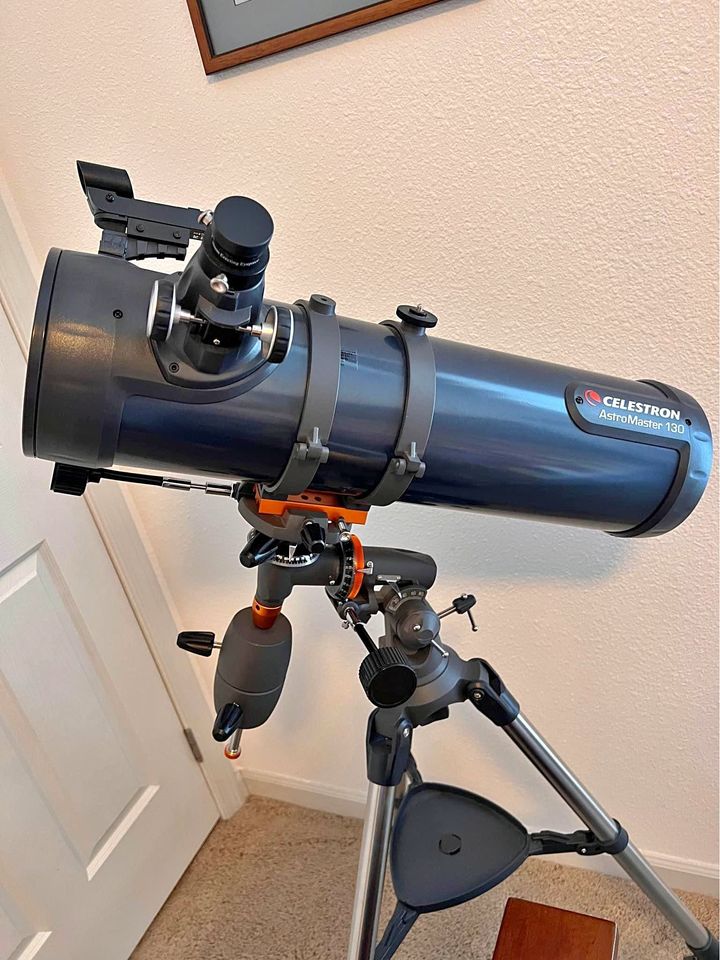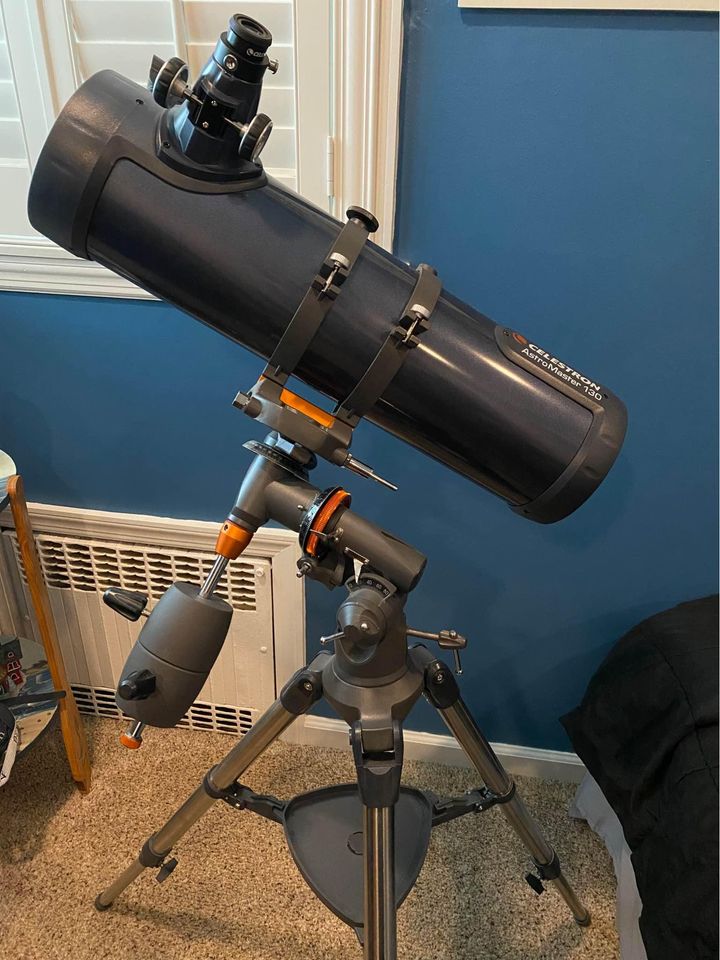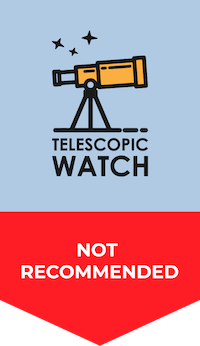Overview of Astromaster 130EQ Optics Performance
The Celestron AstroMaster 130EQ is a 130mm f/5 Newtonian. At least on paper, it’s identical to Celestron’s StarSense Explorer, Omni XLT, Astro-Fi 130, SkyProdigy 130, and NexStar SLT 130mm telescopes, as well as the venerable Astronomers Without Borders OneSky, Zhumell Z130, and others. However, trouble has arisen with the AstroMaster 130EQ scopes lately.
Seemingly as part of an effort to reduce manufacturing costs and maximise profit, Celestron is putting spherical primary mirrors in at least some of its AstroMaster 130EQ units. These mirrors cannot focus light correctly (a proper Newtonian telescope uses a parabolic mirror), and they make the telescope nearly unusable at high magnifications.
The bulk of the AstroMaster 130 scopes I’ve seen have had acceptable primary mirrors–usually not quite parabolic but not quite spherical either–but a few have had spherical primaries that made for mushy views. I’ve also seen a few with great optics.

When consulted, Celestron gives varying answers as to whether the AstroMaster 130 scopes are sold with spherical mirrors or not. One should not have to play the lottery to get a decent instrument with hundreds of dollars on the line, and Celestron should be able to give a concrete answer as to the nature of their product. This alone disqualifies the AstroMaster 130 from being a serious recommendation in our book.
The rest of the 130’s optical tube is fairly standard in its design and function. Both the primary and secondary mirrors are fully collimatable, and the focuser is a standard plastic 1.25” rack-and-pinion unit. The tube attaches to its mount with a pair of felt-lined metal tube rings and a short Vixen-style dovetail, which allows the scope to be balanced and the eyepiece rotated to a comfortable position, as well as for the scope to be installed on a different mount. One of the rings has a small ¼ 20 threaded screw/knob that allows you to piggyback a DSLR on top – if the mount is motorised with an aftermarket clock drive such as Celestron’s Logic Drive, it will work well enough for wide-field astrophotography.
The Quality of Eyepieces Supplied with 130EQ
The 130EQ, like all of the AstroMaster Newtonian reflector models, comes with a 20mm erecting Kellner eyepiece for low magnification views. This eyepiece is identical to the one supplied with Celestron’s PowerSeeker scopes. As for why Celestron supplies it, the answer is simple. All of the AstroMasters are advertised as usable for terrestrial viewing because Celestron has managed to convince consumers that a Newtonian reflector on an equatorial mount is designed for such use. This useless gimmick of a feature has resulted in an eyepiece with a roughly 30-degree apparent field of view, lots of internal reflections and light loss, fuzzy images, and an almost entirely plastic build. It’s also a bit too much magnification (33x) to be a great low-power “finder” eyepiece, and thanks to its narrow apparent field, it only gives a true field of view of 0.9 degrees—less than two full moons across, making it difficult to find many objects. Galileo himself would probably complain about the abysmally low quality of this eyepiece.
The 10mm Kellner supplied for medium power (65x with the 130EQ) works well, and thanks to its much greater and more reasonable apparent field of view (around 50 degrees) it actually achieves a similar true field to the 20mm Kellner.
The Finderscope
The Celestron AstroMasters used to come with a strangely designed, cheap, built-in, non-removable red-dot finder that had a nice switch and glass window, but suffered from alignment problems. Newer AstroMasters have a standard, run-of-the-mill red dot finder attached to them with a strange plastic jig. I find the placement a little odd, but it is actually more comfortable to reach than the standard location of finders on a lot of telescopes.
Reviewing the CG-3 Equatorial Mount
The 130EQ comes on a lightweight German equatorial mount that Celestron calls the CG-3. While not the heaviest duty thing you can buy, the mount works well enough for the 130mm f/5 OTA and it should work okay with a DSLR camera piggybacked on top.
Another thing to consider is that German equatorial mounts like the CG-3 are not the most comfortable ergonomically with a Newtonian telescope. The eyepiece can wind up in some odd positions. The 130EQ optical tube can be rotated in its rings to adjust the position of the eyepiece, but you could easily throw off the balance and/or skew the pointing of the telescope in the process of doing so.
The CG-3 comes with flexible slow motion controls for adjustments on both axes. However, you’ll need to switch the right ascension cable from one side of the mount to the other depending on where you’re looking in the sky. The mount has no polar scope, but for a scope meant for visual use and most simple astrophotography, this isn’t really an issue. The mount does have slow-motion altitude and azimuth adjustments for precise polar alignment.

The CG-3 has a Vixen dovetail saddle so in theory you could put a different optical tube on it, but it wouldn’t really make financial sense to do so under most circumstances.
The CG-3 can be equipped with Celestron’s “Logic Drive” for hands-free tracking. The drive also allows for piggyback astrophotography, but even this will probably strain the mount somewhat.
What can you see with the Celestron AstroMaster 130EQ?
Even if you are unfortunate enough to get a sample with mediocre to poor optics, the Celestron AstroMaster 130 can show you a lot of deep sky objects, provided you obtain a better low-power eyepiece than the one included with the telescope. The brighter open star clusters and nebulae such as the Orion, Lagoon, and Swan will look fantastic with half-decent skies. Some of the bright galaxies, such as Andromeda, M82, and M64, will show their dust lanes, and under really dark skies, M51 and M101 might just reveal their spiral arms.
Within the solar system, you’re limited primarily by the scope’s optical quality. With a good sample of the 130EQ, Jupiter’s Great Red Spot, the Cassini division in Saturn’s rings, the ice caps and albedo markings of Mars, and even the tiniest lunar craters (as small as a few miles across) are visible with the telescope. With a poor unit, the planets are mushy and devoid of fine detail, though the rings of Saturn and the cloud belts of Jupiter are still visible and the Moon may look acceptable to a beginner.
Alternative Recommendations
For the same price as or a little more than that of the AstroMaster 130EQ, there are a number of other, much higher-quality telescopes you should definitely consider instead, including the following:
- The Apertura DT6 offers a significant boost in aperture, much better build and optical quality, superior accessories, and a stable, easy-to-use Dobsonian mount.
- The Sky-Watcher 6” Traditional provides similar capabilities to the SkyLine 6 but with a true 2” focuser, allowing for the use of 2” eyepieces.
- The Sky-Watcher Heritage 130p offers the same aperture as the 130EQ but with better optics, better accessories, a collapsible tube, and a simple tabletop Dobsonian mount.
- The Zhumell Z130, like the Heritage, offers superior accessories, optics, and a simpler mount than the 130EQ but with a closed tube design.
Aftermarket Accessory Recommendations
High-quality aftermarket eyepieces can at least make the observational experience with your AstroMaster 130EQ somewhat enjoyable, even with its imperfect optics and mounting. The 130EQ’s provided 20mm erecting eyepiece is entirely ruins low-power viewing, where the telescope can still deliver sharp views with no issues. A good low-power eyepiece, such as a 25mm Plossl (26x), is far sharper than the 20mm erecting eyepiece and offers the widest practical field of view with this scope, making it ideal for observing deep-sky objects. A 15mm “redline” or “goldline” eyepiece (43x) fits well between the 32mm and the provided 10mm eyepieces, while a 7mm planetary eyepiece (93x) provides about the highest magnification you can use with the AstroMaster 130EQ before the flawed spherical mirrors no longer provide a sharp or even acceptable image.
You can also equip the AstroMaster 130EQ with Celestron’s Logic Drive for hands-free tracking if you did not purchase the version with the drive bundled by default.
Astrophotography with Astromaster 130EQ
Neither the CG-3 mount nor the AstroMaster’s focuser are heavy duty enough for astrophotography with a DSLR, though webcam planetary imaging is in theory possible with a 3x or 5x Barlow lens coupled to the optical tube. But in practice, you’re really limited to shots with a mobile phone or the like – and this is assuming the mirror is parabolic and not spherical, which is a real gamble.


